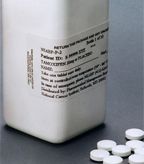Recurrence After Tamoxifen Could Be Dictated by Gene Expression
The expression levels of two genes could indicate whether a woman with estrogen receptor-positive breast cancer is at risk for recurrence after 5 years of tamoxifen therapy and should receive subsequent therapy.
The expression levels of two genes could indicate whether a woman with estrogen receptor (ER)-positive breast cancer is at risk for recurrence after 5 years of tamoxifen therapy and should receive subsequent therapy. The marker also predicted benefit from therapy with letrozole (Femara) after 5 years of tamoxifen.

While the majority of ER-positive breast cancer patients are disease-free after 5 years of adjuvant hormonal therapy, as many as 50% of these patients recur in the decade following completion of their adjuvant treatment. “Our biomarker identifies the subset of patients in this population that are both vulnerable to a late recurrence and will benefit from extended therapy,” said Dennis C. Sgroi, MD, director of breast cancer pathology at the Massachusetts General Hospital Cancer Center, lead author of the study.
Researchers at the Massachusetts General Hospital Cancer Center analyzed patients from the Clinical Trials Group MA.17 trial who had either recurred (83 patients) or did not recur (166 patients). This study is a prospective-retrospective, case-control study. The MA.17 trial was a randomized, placebo-controlled trial that showed letrozole therapy after 5 years of tamoxifen can improve disease-free survival, distant disease-free survival, and overall survival in postmenopausal women with hormone receptor–positive breast cancer. The new results are published in the Journal of the National Cancer Institute.
Recently, 10 years of tamoxifen was shown to result in both lower risk of later recurrence and a lower risk of death compared to 5 years of treatment in two studies (link). Women are also prescribed letrozole, an aromatase inhibitor, after tamoxifen. Aromatase inhibitors are also prescribed as an upfront adjuvant therapy for women with postmenopausal ER-positive early breast cancer.
Two gene assays have been shown to predict whether a woman with ER-positive breast cancer is at risk of recurrence within the first 5 years of adjuvant therapy: the 21-gene recurrence risk assay and the 70-gene assay.
Still, it is not clear how to identify which patients will benefit from longer-term treatment, beyond 5 years, which comes with substantial side effects. Women who are cancer-free after a 5-year regimen are still at risk for recurrence for another 10 years. There are no biomarkers currently recommended in guidelines that can predict who will benefit from endocrine adjuvant therapy beyond 5 years to prevent this delayed recurrence.
Sgroi and colleagues previously showed that the gene expression ratio of the HOXB13 and IL17BR genes (H/I) is a prognostic biomarker in both those women with ER-positive early-stage, lymph node–negative breast cancer who are untreated or tamoxifen-treated. The assay is performed at initial diagnosis using tumor tissue.
The current study shows that H/I can, at diagnosis, identify the subset of ER-positive breast cancer patients who are at higher risk for recurrence after 5 years of tamoxifen therapy. These same patients will benefit from extended letrozole therapy, according to the results.
“Our biomarker should allow many women to avoid unnecessary extended anti-hormonal treatment, and provides an important tool for aiding in the management of residual risk after 5 years of treatment that is a significant unmet need for [ER-positive] breast cancer,” said Sgroi.
Previously the HOXB13 and IL17BR gene expression ratio combined with the Molecular Grade Index, a five-gene index, together called the Breast Cancer Index, was shown to be a molecular tool that could determine both early risk of recurrence and later recurrence, beyond 5 years of initial adjuvant therapy (link).
Sgroi and colleagues analyzed tumor samples from 83 patients who recurred after 5 years of tamoxifen. Of these 83 patients, 31 received subsequent letrozole and 52 patients received placebo on the MA.17 trial. The team analyzed samples from an additional 166 patients who did not recur while on the trial (91 received letrozole, 75 placebo).
Patients on placebo with a high ratio of HOXB13 to IL17BR expression were at increased risk for tumor recurrence after tamoxifen therapy (P = .03). The result remained marginally significant after adjusting for age, tumor size, and grade, and other patient and pathology factors (P = .05). Those patients who had a high H/I ratio but received letrozole had a 67% reduction in risk of recurrence compared with women who had a high H/I ratio but took placebo after adjusting for patient and pathology factors (P = .006). This relative reduction in risk of recurrence translates to a 16.5% reduction in absolute risk of recurrence at 5 years with letrozole compared to placebo, according to the authors.
The clinical benefit from letrozole in this smaller cohort study was similar to the results of the entire population in the MA.17 trial, according to the researchers.
The authors compared the prognostic and predictive biomarker to HER2 expression. Just as higher expression of HER2 suggests a worse prognosis for these HER2-positive breast cancer patients (but indicates a positive response to HER-targeted therapy), a high H/I index is associated with a higher risk of relapse but a favorable response to letrozole therapy.
This result, if confirmed in larger studies, has the potential to provide an easier choice about long-term recurrence prevention therapy and allow those women who are not likely to benefit from such therapy to avoid such unnecessary therapy.
Sgroi and colleagues are now extending their findings from the MA.17 trial by analyzing the National Surgical Adjuvant Breast and Bowel Project B42 trial. The B42 trial randomized those breast cancer patients who were disease free after 5 years of an aromatase inhibitor therapy to either placebo or an additional 5 years of an aromatase inhibitor.